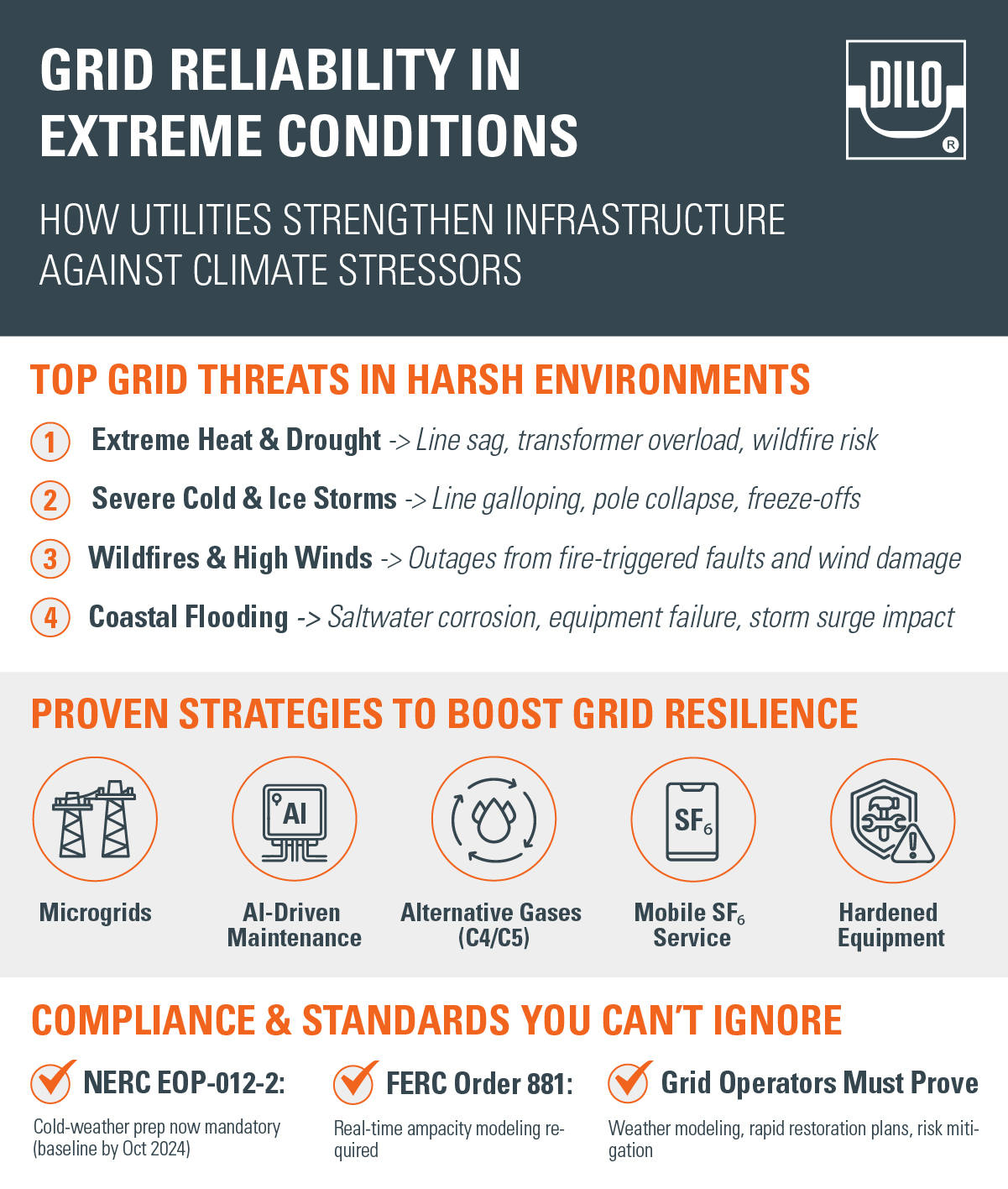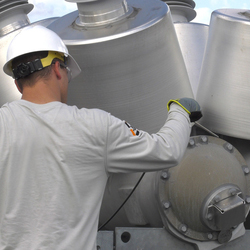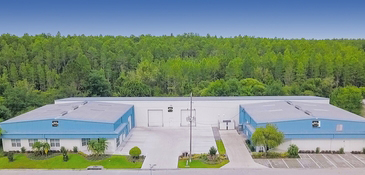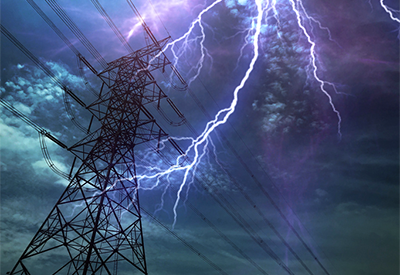How to Ensure Grid Reliability in Harsh Environmental Conditions
On June 24, 2025, a blistering heat wave across the western U.S. sent wholesale electricity prices soaring to nearly double their seasonal average and forced emergency alerts in multiple balancing areas. This event, one of the latest in a string of climate-driven grid disruptions, underscored the urgent need to harden energy infrastructure against increasingly volatile conditions. Although electric grid reliability has always been a foundational concern for utilities and regulators, today’s stakes are higher than ever, both operationally and financially.
Extreme weather is putting more pressure on aging energy infrastructure. Events like droughts, ice storms, wildfires, and coastal flooding are causing more frequent and severe power outages. To keep the grid reliable, utilities must strengthen the entire system, follow updated NERC and FERC standards, and invest in technologies that can help prevent these failures before they happen.
Why Grid Reliability Matters Amid Extreme Weather Surges
To understand how to protect electric systems, we first need to clarify what’s being protected. Grid reliability, resilience, and power quality (terms often used interchangeably) are actually distinct metrics:
- Reliability refers to the system’s ability to deliver power consistently without interruptions.
- Resilience describes the system’s ability to adapt, absorb, and recover from disruptions, especially extreme weather.
- Power quality concerns the consistency and purity of the electrical signal (voltage and frequency).
Regulators use metrics like SAIDI (System Average Interruption Duration Index) and SAIFI (System Average Interruption Frequency Index) to benchmark performance. According to the NERC State of Reliability 2024 Technical Assessment, weather remains the leading cause of interruption minutes across all transmission reliability events.
The challenge is compounding. U.S. load demand is projected to rise by 128 GW by 2035, driven by electrification, AI data centers, and extreme temperature-driven cooling loads. Strengthening the grid is no longer a long-term improvement; it's now essential for daily operations.

Environmental Stressors That Threaten Today’s Grids
More than 70% of all unplanned outages in 2024 were triggered by just four types of environmental stressors, according to NERC’s latest assessments. Each presents unique mechanical and operational threats, and each requires targeted mitigation.
Extreme Heat & Drought
Higher ambient temperatures reduce conductor ampacity and accelerate asset degradation. Heat causes transmission lines to sag, increasing the likelihood of vegetation contact and flashover events. For instance, ACSR conductors can sag from 2" to 9" as temperature rises from 80°F to 200°F, according to We Energies ACSR Sag Tables.
During the 2024 Southwest heat wave, transformers had to be derated to avoid overheating, leading to localized capacity shortages. Wildfire risks also grow under drought conditions, triggering frequent Public Safety Power Shutoffs (PSPS) across California and other high-risk zones.
One notable event, the Park Fire in 2024, burned over 350,000 acres within its first 72 hours, according to the National Interagency Fire Center. Wildfires like these cause both immediate service disruptions and long-term infrastructure damage.
To limit ignition risk and environmental impact, some operators are considering to upgrade their gas insulated equipment toC4/C5 alternative-gas equipment C4/CA and other insulating alternatives in sensitive areas, reducing reliance on traditional SF₆-insulated switchgear.
Severe Cold & Ice Storms
Icing events can drastically increase conductor weight, causing line galloping, mechanical fatigue, and in many cases, pole collapse or tower failure. Ice accretion can multiply line weight by a factor of 3 to 5, depending on humidity, wind speed, and freezing rain intensity. This added stress, coupled with wind-induced motion, destabilizes the physical grid and accelerates wear on insulators and fittings. Line galloping also increases the risk of phase-to-phase contact and flashovers, creating systemwide reliability hazards.
The 2021 Texas Winter Storm Uri is an example of the consequences of cold-weather unpreparedness: gas supply lines froze, coal piles solidified, and multiple generation assets went offline simultaneously. As temperatures plummeted, nearly 4.5 million customers lost power, many for several days. The resulting SAIDI spike was among the worst in U.S. history, as detailed in the FERC/NERC joint final report.
In response, NERC’s EOP-012-2 standard now mandates that transmission and generation operators develop and document cold-weather preparedness plans. These must include generator freeze protection, backup fuel strategies, and pre-winter inspections. Baseline implementation is required by October 1, 2024, with full compliance by 2026, as confirmed in the NERC August 2024 Compliance Bulletin.
These requirements focus on proving that equipment actually works during extreme cold, not just on having a plan. This change ensures that reliability matches the real challenges posed by severe weather.
Wildfires & High Winds
Wildfires are among the most devastating environmental events in terms of both acreage burned and outage hours.Figure 2.12 from the 2024 NERC reliability report shows that fire-related transmission events accounted for more than 6 million customer outage-minutes between 2019 and 2023. These outages often occur in clusters, reflecting how fire behavior impacts multiple lines or substations simultaneously.
High winds exacerbate fire risks by damaging conductors, breaking insulators, and spreading embers over vast distances, sometimes miles ahead of the fireline. Wind-driven ignitions can trigger cascading failures if utilities lack sectionalization controls or rapid reclose coordination.
In the western U.S., utilities have responded by implementing Public Safety Power Shutoffs (PSPS) and investing in advanced wildfire modeling tools. These systems incorporate real-time weather data, fuel moisture levels, and line loadings to determine when proactive shutoffs are warranted. Yet even with these advances, risks remain. Aging infrastructure, such as cracked ceramic insulators and unshielded wood poles, continues to serve as ignition sources under stress. In some cases, line failure from high winds precedes the fire itself.
Vegetation management, while essential, provides limited protection during high-wind red flag conditions. Utility corridors cleared to regulatory standards may still harbor dry grasses or shrubs capable of igniting from minor arc flashes. The Park Fire in 2024, for example, burned over 350,000 acres within 72 hours, according to the National Interagency Fire Center. Suppression crews struggled to keep pace due to simultaneous grid-triggered ignitions across multiple counties.
To improve both detection and response, some operators now equip inspection teams with thermal imaging drones and deploy fire-resistant conductor coatings. Others contracton-site service contractors that specialize in gas insulated equipment services to inspect and restore gas-insulated switchgear immediately after fire events. By reducing SF₆ emissions during recovery and servicing damaged GIS assets rapidly, utilities can return key substations to service while maintaining regulatory compliance.
Ultimately, grid resilience in fire zones requires layered strategies: automated shutdowns, hardened infrastructure, intelligent weather analytics, and field-deployable diagnostics that shorten restoration windows and reduce risk to personnel.
Coastal Flooding & Hurricanes
Storm surge and saltwater corrosion can devastate substations and transmission towers, particularly in low-lying coastal regions where sea level rise and increasingly intense hurricanes amplify long-term risk. Water ingress into switchgear and control rooms causes widespread equipment failure, while salt spray accelerates rust and insulator degradation, often leading to flashovers and outages that are difficult to isolate.
During Hurricane Idalia in August 2023, utilities across Florida and Georgia faced widespread substation damage and feeder line disruptions. Duke Energy Florida alone incurred approximately $1.09 billion in restoration costs, receiving cost recovery approval from state regulators, according to the Florida Public Service Commission. Much of the cost stemmed from waterlogged distribution assets, damaged transformer yards, and labor-intensive cleanup efforts.
Strengthening coastal power infrastructure takes a combination of smart design choices. One key strategy is raising substations above past storm surge levels to keep them dry during floods. Utilities also use corrosion-resistant materials, like stainless-steel housings and weather-sealed connectors, to protect equipment from saltwater damage. In areas with tides or strong currents, special foundations help keep towers stable and prevent erosion. Engineers must also design for strong winds and flying debris, especially for equipment installed near the coast.
Microgrids play an essential role in keeping essential services, such as hospitals, emergency shelters, and water systems, running when the main grid goes down. These local power systems can operate on their own during outages. Combined with batteries and backup power sources like diesel generators or solar panels, microgrids help ensure that critical operations continue, even if repairs take days. For coastal communities facing stronger storms and longer recovery times, microgrids are becoming a must-have for resilience.
Complying with New Standards: NERC, FERC, and Beyond
Regulators are moving from offering recommendations to actively enforcing rules. The NERC Reliability Standards, particularly TPL-001-5.1, EOP-011, and EOP-012-2, now require proof of weather event modeling, grid stress testing, and rapid restoration planning.
FERC’s evolving oversight, including Order 881, further mandates dynamic line ratings and more accurate real-time ampacity modeling. Grid operators must show that their systems can withstand not only N-1 failures but increasingly likely “N-W” failures (where W = weather).
Physical and Digital Hardening Strategies That Work
Undergrounding vs Overhead Hardening
Although undergrounding is often seen as a gold standard for grid resilience, it’s not always cost-effective. In wildfire-prone areas, undergrounding can cost 5–10 times more per mile than overhead reinforcement, according to the U.S. Department of Energy. Overhead hardening, such as composite poles, fire-resistant conductors, and advanced line monitoring, can achieve significant resilience gains at lower capital expense.
In high-density areas or flood zones, undergrounding remains essential. For rural or mountainous terrain, strategic overhead upgrades may offer better ROI.
Distributed Systems and Microgrids
Microgrids offer a highly effective resilience layer for critical facilities. During the 2023 ice storms in Vermont, Green Mountain Power’s community microgrids kept several rural healthcare and emergency services online even as the broader transmission system failed. These isolated from the main grid power systems leverage a mix of battery storage, solar PV, and backup generation to maintain power without relying on central transmission.
But can microgrids guarantee uninterrupted service during events like hurricanes? Not always. They require robust communication systems and fault isolation capabilities. For hospitals and data centers, however, well-designed microgrids have become an indispensable part of continuity planning.
Battery Storage for Peak and Backup
Battery energy storage systems (BESS) are becoming integral for grid resilience, especially when paired with renewables. A 4-hour 50 MW/200 MWh system can offset peak loads in a mid-sized community and provide critical support during a transmission failure.
While the capital costs are still high, declining lithium-ion prices and regulatory incentives make BESS more feasible, particularly for utilities seeking to defer costly infrastructure upgrades.
AI-Driven Predictive Maintenance
AI-powered grid diagnostics are already used in many major U.S. utilities. These systems use sensors, thermal imaging, and machine learning to detect faults, predict equipment failure, and prioritize field interventions. A recent report from Berkeley Lab highlights the increasing role of AI in improving grid resilience.
Combined withSF6 gas handling trained and certified technicians and digital inspections, predictive analytics help extend asset life and prevent failures due to insulator flashover, gas leaks, or corrosion, common triggers during extreme events.
For utilities that manage high volumes of gas-insulated equipment, utilizing gas-handling products that offer safe, standards-compliant solutions. Field teams can also rely on trained and experienced service partners such as, In-Gas Direct, foron site service & certified gas supply for rapid response and equipment servicing during weather emergencies.
Funding, ROI, and the Regulatory Question
One of the most frequent questions in boardrooms and rate cases is: Who pays for grid hardening — ratepayers or shareholders? The answer varies by state and jurisdiction, but increasingly, regulators are allowing cost recovery when utilities can demonstrate both risk reduction and ratepayer benefit.
Federal programs like the DOE's Grid Resilience and Innovation Partnership (GRIP) and FEMA’s BRIC program offer funding paths for qualified projects. Showing alignment with NERC reliability standards and quantifying the ROI in terms of avoided outage minutes and restoration costs can accelerate both public and private investment approvals.
Conclusion: Build a Resilience Playbook That’s Standards-Aligned and Future-Ready
Harsh environmental conditions aren’t going away. In fact, they’re becoming the norm. Building a resilient grid in the face of extreme weather and harsh environments demands a comprehensive approach that integrates physical upgrades, cutting-edge digital technologies, and distributed energy solutions.
Strengthening poles and lines, integrating AI-driven predictive maintenance, and using microgrids and alternative-gas technologies together create a resilient, adaptive power system capable of withstanding heat waves, ice storms, wildfires, and floods.
To help you assess your current setup and develop a tailored hardening plan, book a 30-minute Grid Resilience Consultation. Schedule a live video call with a DILO field engineer who will review your existing SF₆ or alternative-gas inventory, identify vulnerabilities, and recommend customized solutions to bolster your grid’s reliability.
DILO’s expertise, from C4/CA (SF6 Alternatives) equipment toSF6 gas handling training, provides the tools and knowledge you need to build a future-ready, standards-aligned resilience playbook designed specifically for harsh environments.
Start strengthening your power grid resilience today! Schedule your consultation and take the first step toward a more resilient energy future.





